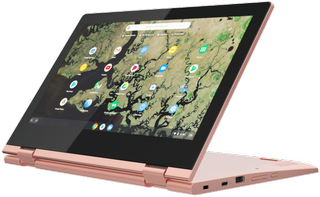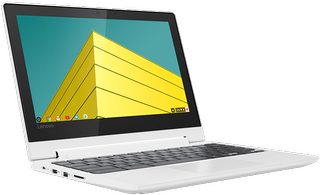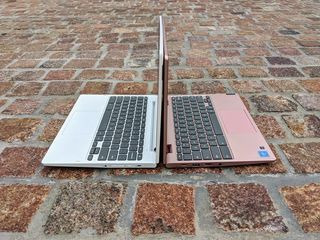Lenovo Chromebook C340 vs. Lenovo Chromebook C330: Which should you buy?

Lenovo Chromebook C340-11

Lenovo's follow-up to its most popular Chromebook brings some class and extra productivity to a compact machine that could already run all day with ease. Combined with aggressive pricing and two color options, the C340-11 is a slam dunk Chromebook.
Lenovo Chromebook C340-11
New best Chromebook
Lenovo Chromebook C330

The C330 is a great Chromebook, but it's practically the same price as the new model without the extra ports, extra colors, or the iron-clad guarantee that it will receive updates after June 2023. When it gets steeper sales, it's a good budget buy, but right now its only advantage is that it's widely available.
Lenovo Chromebook C330
Bargain buy
Lenovo hit a home-run with the affordable workhorse Lenovo Chromebook C330, but there were some minor complaints that the company tried to remedy with its successor. At long last, the C340 is here, and now that it is out and on sale, the decision between the new and old models is a surprisingly simple choice to make.
Well, at least it would be simple if they could both stay in stock.
Same song, stronger verse

When you hold the two generations of the C330 line up to each other, they're practically twins. The C340-11 is slightly smaller in all directions — the depth most notably — and the keyboard isn't quite as rounded at the edges, but typing experience and the trackpad are the same. While the C330 is an all-plastic affair, the C340-11 dresses up a bit fancier with an aluminum lid, though the rest of the body is plastic. Despite the switch to a metal lid, the weight is the same, and it's just as easy to carry the C340-11 around a busy classroom or a crowded cafe as its predecessor.
Yes, the bezels are still huge, but that makes it easier to hold the C340-11 in tablet mode without accidental taps on the screen. The screens between the old and new generation are the same on paper, though my C340's screen is a bit cooler than the slightly yellow screen on my C330. Both get bright enough to use in the shade outdoors and dim enough to use in a dim dorm room without waking your roommate.

There's also two color options for the C340-11, a delightfully rosy Sand Pink and the more neutral Platinum Gray. The Sand Pink is a lovely shade that brings some much-needed personality to a Chromebook market oversaturated with blacks and grays. Even more important than the slight cosmetic changes are the additions of extra USB ports and larger volume and power buttons.
Be an expert in 5 minutes
Get the latest news from Android Central, your trusted companion in the world of Android
| Category | Lenovo Chromebook C340-11 | Lenovo Chromebook C330 |
|---|---|---|
| Display | 11.6 inches1366 x 76810-point IPS touchscreen250 nits brightness | 11.6 inches1366 x 76810-point IPS touchscreen250 nits brightness |
| Processor | Intel Celeron N4000 | MediaTek MT8173C |
| Memory | 4-8GB | 4GB |
| Storage | 32-64GB eMMc | 32-64GB eMMc |
| Expandable Storage | microSD card | SD card |
| Connectivity | Wi-Fi 802.11acBluetooth 4.2 | Wi-Fi 802.11acBluetooth 4.1 |
| Ports | 2x USB-C USB 3.1 Type-C Gen 12x USB-A USB 3.1 Gen 11x Audio combo jack | 1x USB-C USB 3.1 Type-C Gen 11x USB-A USB 3.1 Gen 1HDMI 1.41x Audio combo jack |
| Battery | Li-Ion 42Wh (10 hours)45W USB-C AC adapter | Li-Ion 45Wh (10 hours)45W USB-C AC adapter |
| Dimensions | 290 x 207.8 x 17.8 mm(11.4" x 8.18" x 0.7") | 292 x 215 x 19.6 mm(11.50" x 8.46" x 0.77") |
| Weight | 2.6 lbs (1.18 kg) | 2.64 lbs (1.2kg) |
| Auto Update Expiration Date | June 2025 | June 2025*Reliant upon component suppliers |
You'll notice there's not a whole lot of differences in that spec table, but make no mistake, the few changes made here are significant, especially in regards to memory and available ports. Having a USB-C and USB-A port on each side of the Chromebook makes things significantly easier when you're plugging it in to charge. It also gives you a fallback if somehow you manage to break one of these reinforced ports.
I would be heaping on the praises of Lenovo for including an 8GB RAM option for the C340-11, but until those models actually are available for purchase, it's just a number on a page. When an 8GB/64GB C340-11 is available, it is 100% the model you'll want to buy, but 4GB has been enough for me to work with as I keep 8-12 tabs open at a time and a couple Android apps handy. More RAM is always better in a Chromebook, but 4GB is enough to get by today.
The C330's only real failing last year was that it had a short support life: when it was announced it had an AUE date of June 2022. Google announced end-of-life extensions for several Lenovo Chromebooks, most notably the C330, but the new AUE date of June 2025 isn't set in stone. It's reliant on component suppliers helping Google ensure that new Chrome OS updates are compatible with their parts past the original AUE date.
There are few reasons you'd want to choose the C330 over the C340-11 unless you really need an HDMI port on the Chromebook itself or you prefer the Blizzard White plastic over the new shiny aluminum lids. Normally, the C330 would be $70 or more less than the C340, but the Chromebook shortages of late have driven the C330 back up to their original MSRP — or even higher, in some places — while the C340-11 has been simply sold out at just about every major retailer except Best Buy.
If you can find the C340-11 in stock, get that one, but if you absolutely need one ASAP, the C330 is still a great Chromebook. Whichever model you can find, try to get a 64GB model if at all possible, as there are some things a microSD card simply can't replace internal storage for, like app data.

Better in every way and prettier to boot.
Double the USB ports and a more powerful Intel processor sweeten the pot on last year's best workhorse Chromebook. The Aluminum lid and two color options give the C340-11 a more premium feel without giving it a premium price hike.

Last year's model is still pretty great.
If you don't mind having fewer USB ports and a slightly shorter support life, the Lenovo Chromebook C330 is still an excellent little workhorse, and it's definitely easier to come by right now than the elusive C340-11.
Ara Wagoner was a staff writer at Android Central. She themes phones and pokes YouTube Music with a stick. When she's not writing about cases, Chromebooks, or customization, she's wandering around Walt Disney World. If you see her without headphones, RUN. You can follow her on Twitter at @arawagco.

